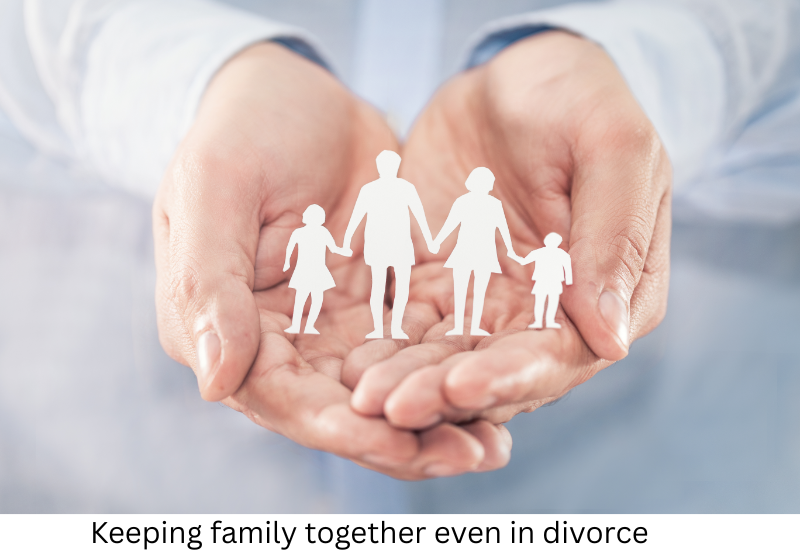“Divorce is where two adults take everything that matters to a child – the child’s home, family, security and sense of being loved and protected – and they smash it all up, leave it in ruins on the floor, then walk out and leave the child to clean up the mess.” Michael Reagan, son of President Ronald Reagan. If this is the reality for many children of divorce, how can parents change it? How do you move from destroying everything that matters to children to protecting children? How can you give children what they really need in divorce?
People generally believe one of two lies about children in divorce:
1) Children are resilient—they will be fine. The statistics clearly show that often children don’t turn out fine but, instead, deeply wounded.
2) Divorce always destroys children. Also, untrue. Some families protect children even as parents end their marriage.
So, what can you do to give your children what they need?
Choose the right process for children
As parents, you have choices in how to divorce—adversarially or cooperatively. Your process defines results.
If you proceed in a win vs. lose adversarial process—where two attorneys battle for more parenting time, more money, and more assets—your children pay the price.
Children resent those who hurt their parents. If one parent wins more time or more money, children often resent that parent. They feel required to defend and protect the other. They then become the carnage of their parents’ battle.
The alternative—a cooperative process. A process where you focus on making decisions that prioritize protecting children. This means ensuring both parents are as stable as possible.
Financial decisions focus on financial security for both. Parenting plan decisions focus on enhancing children’s relationships with both. You work together to create agreements that redefine your family in a way that works. You don’t have to be buddy-buddy. Just willing to work together for the best for your children.
View children rightly
In divorce, children are typically viewed in two ways—either as property or as people. Parents who:
- haggle over time with children to either gain more child support or pay less,
- who keep children from the other parent to punish that parent, or
- who dangle children as bait to get their way
see children as property.
Parents who see children as people work to make decisions that revolve around:
- how best to care for children.
- how to ensure children securely relate to both parents—even when one or both struggles to parent well, and
- around working cooperatively with and supportively of each other (even if you have to grit your teeth to do so).
Instead of taking on the role of peacekeeper, children get to just be children.
Provide children security
Children’s security comes from their parents’ relationship. When the pattern at home is that parents talk together about decisions, work together on tasks, support each other emotionally, and show affection—even with the normal flaws all couples have—security naturally flows to children. Children rest in the functional, healthy relationship between parents.
When parents struggle to do any of the above and the pattern is cold isolation or hostile battling, children’s security is eaten away. A contentious divorce takes away even more security.
Yet, a healthy co-parenting relationship works nearly as effectively as a healthy marriage to create secure children. The more the two of you work together to make decisions for children (or, at minimum, honor the separate decisions in each home); share the load on activities, finances, and care; and speak supportively of each other—the more secure your children will be. And, secure children thrive. Even post-divorce.
Provide predictability for children
In your parenting plans, create care schedules that are easily predictable for children. When children know which days they are with each parent, who is getting them to practice, and from whom to ask permission—life gets easier.
Similar rules in both homes also offers predictability. Though you will, of course, create your own home’s identity and culture, the more both homes reflect similar expectations for children—the easier it becomes for children to meet those expectations. Younger children especially thrive if the basic routine is the same—i.e. bedtimes, amount of screen time, expectations on behavior, and consequences for misbehavior.
This also helps you as a parent. Children are much less likely to try to play parents off each other if both homes generally expect the same from them.
Ensure financial support for children
Children thrive when both parents are as financially secure as possible and both contribute to their needs. As the two of you make decisions in your divorce, you best serve your children when you create well-informed expectations of each other when it comes to financial support for children.
Child support is one element. Yet, child support only focuses on essential expenses (e.g. food, clothing, shelter, childcare, health insurance, non-reimbursed health expenses and school expenses). More, the child support calculation comes through an algorithm that cannot take into account your specific circumstances. You will also need to consider other expenses such as sports, extra-curricular activities, cell phones, cars, etc.
The more specifically you can define children’s expenses in all these categories, the better you will be able to work together to create a plan for how to share them equitably.
Some parents:
- split each expense based on an agreed percentage,
- some assign differing expenses (such as one parent pays sports and cell phones while the other pays lessons and car insurance), and
- others use a joint children’s account to each make agreed deposits and then each using the account to pay the summer camp or piano lesson as it comes due.
The point—the more cooperative you are with each other, the more options you have to support the children well.
This cooperation concretely demonstrates to children that they will be ok, even in divorce. It builds their trust that each of you cares for them. More, that neither of you is taking advantage of the other. This relieves them of the burden of protecting a parent or feeling guilty about their desire to engage in the normal activities of childhood.
Money represents values and priorities. When you each invest money in your children, they feel valued and that they are a priority.
Answer children’s questions
When parents share their decision to divorce, children’s questions abound. Some children are quick to think of questions—others take a while. Whenever the questions come, answer in ways that keep the dialogue open and children part of the process. This includes:
- Be wise in answering. When you know the answer, give it. When you don’t, don’t make promises you may not be able to keep. If they ask whether they can stay in their school and you aren’t sure, offer something like, “We aren’t sure, but we are trying. As soon as we know, you will know.”
- Answer in developmentally appropriate ways. Younger children need specific and simple; older often want more explanation and detail. If you need assistance on what to say—speak to their teacher, counselor, or your mediator about good options.
- Refrain from blaming. However you feel about the other parent, children need you to be a team for them. Even if one desired the divorce or created more of the marital breakdown, don’t burden children by sharing. This pressures them to take a side. There may come a time for children to have more insight—but not while they are still children.
- To the extent you can, offer them opportunities to shape life going forward. Let them help arrange furniture in the new house. Have them prioritize activities they want to keep. Ask what would make moving between homes easier. For one couple, the key for 8-year-old-son was never missing riding the bus. So, when at Dad’s, Dad drove him to Mom’s to catch the bus. Including children’s desires makes the divorce more something they are part of and less something happening to them. Our Child Inclusive Mediation process helps ensure children’s insights are included in decisions.
- Be available. For questions, for conversation, for events, for checking in, for times they just grieve—simply be available for your children. As children experience your ongoing presence in their lives, they trust that, while their parents aren’t married, they didn’t lose their family. It just looks different now.
Divorce doesn’t have to destroy everything that matters to a child. If parents work together to protect family, security, and sense of being loved—children survive and even thrive after divorce.
If you would like more information on navigating all the decisions divorce requires, contact Resolution Mediation for our Couples Mediation by clicking HERE or calling 317-793-0825. We look forward to serving you.
As always, the above is for information only. Seek a professional for guidance in your personal situation. This is an advertisemen



